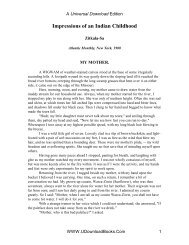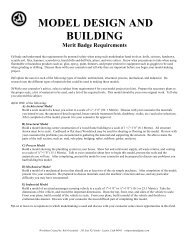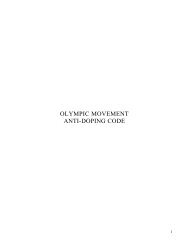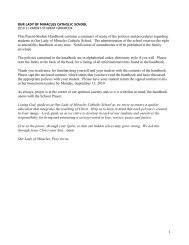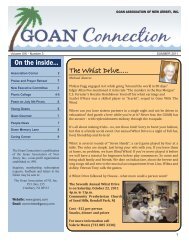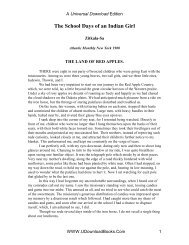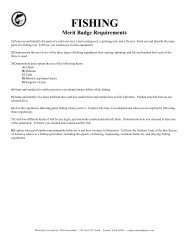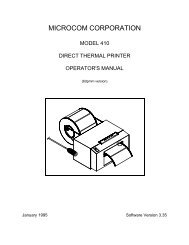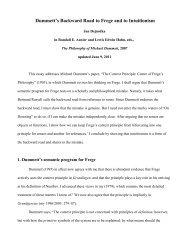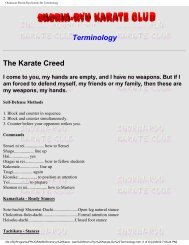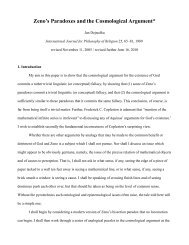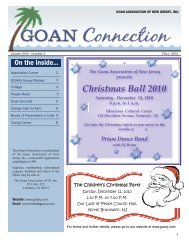2003 Church Youth Co-Rec Softball Rules Sportsmanship The ...
2003 Church Youth Co-Rec Softball Rules Sportsmanship The ...
2003 Church Youth Co-Rec Softball Rules Sportsmanship The ...
Create successful ePaper yourself
Turn your PDF publications into a flip-book with our unique Google optimized e-Paper software.
<strong>Sportsmanship</strong><br />
<strong>2003</strong> <strong>Church</strong> <strong>Youth</strong> <strong>Co</strong>-<strong>Rec</strong> <strong>Softball</strong> <strong>Rules</strong><br />
<strong>The</strong> philosophy of the program is that good sportsmanship is expected in the conduct of every contest. A<br />
good sport is fair, courteous, has a positive attitude, and accepts results gracefully. All individuals and<br />
teams participating should comply with the spirit as well as the written rules that govern all competitive<br />
situations. In order to encourage proper conduct during contests, members of the Red River Valley<br />
<strong>Softball</strong> Association or the League <strong>Co</strong>ordinators will make decisions whether to warn, penalize, or eject<br />
persons, teams, or spectators displaying poor sportsmanship. <strong>The</strong>se members should be treated with<br />
respect. Under no circumstances should these members be threatened or physically abused.<br />
1. Ejection Policy<br />
If a participant is ejected from any game, he/she is immediately ineligible from participating in any<br />
further games until cleared by a member of the Red River Valley <strong>Softball</strong> Association’s Board of<br />
Directors or a League <strong>Co</strong>ordinator. <strong>The</strong> minimum suspension for any participant that was ejected<br />
will be the current game plus one additional game. Infractions that may result in ejection from<br />
intramural competition include the following:<br />
A. Unsportsman-like behavior<br />
B. Verbal Abuse<br />
C. Unnecessary Physical <strong>Co</strong>ntact<br />
D. Fighting (Striking or attempting to strike)<br />
E. Threatening Behavior (Verbal) towards an official or supervisor<br />
F. Threatening Behavior (Physical) towards an official or supervisor<br />
G. Individual playing under an assumed name<br />
H. Individuals playing after the consumption or suspicion of consumption of alcohol/drugs<br />
I. Damage/Destruction of facilities or equipment<br />
2. Forfeit Policy:<br />
A. Teams should arrive 10 minutes before the game to check ID's and complete score sheets.<br />
Teams are expected to begin the game at the scheduled time.<br />
B. <strong>The</strong> games may be not started with less than the minimum number of players, eight (8), If the<br />
minimum number of players is not reached 5 minutes after the schedule game time, a forfeit<br />
will be awarded to the opposing team.<br />
3. Equipment:<br />
A. A 12-inch softball will be used (Slow Pitch) and provided by the Red River Valley <strong>Softball</strong><br />
Association.<br />
B. Bases are in-ground Hollywood-style bases. <strong>The</strong>y do not break away. All other equipment<br />
must be provided by the participants and must be approved under ASA guidelines.<br />
C. Gym shoes or molded rubber cleats are allowed as well as hard plastic cleats. No metal,<br />
screw-in, cleats allowed. All players must wear shoes.<br />
D. Teams may use their own bats provided that the bat:<br />
1. Is not more than 34 inches in length or exceed 38 ounces.<br />
2. Must be marked as an "Official <strong>Softball</strong> Bat" by the manufacturer and approved by the<br />
ASA.<br />
4. Field <strong>Co</strong>nditions/Rainouts:<br />
A. <strong>The</strong> supervisor or coordinator will have responsibility for determining whether a game can be<br />
played or continued due to inclement weather, field conditions, etc. To check on rainouts, call<br />
the Red River Valley <strong>Softball</strong> Association Hot-Line at (218) 979-9331 after 4:00 p.m., the day<br />
of your game.<br />
5. Determining Home Team:<br />
A. A coin flip will determine the home team.<br />
<strong>Rules</strong> of Play:<br />
Play shall be governed by ASA <strong>Rules</strong> except where the following special <strong>Rules</strong> shall apply.<br />
Revised 06/02/<strong>2003</strong> Page 1 of 3
6. Length of Game:<br />
A. Games will be seven (7) innings, or of one (1) hour duration.<br />
B. No new inning may be started 50 minutes after the scheduled beginning of a game.<br />
C. In the event a game ends in a tie after seven (7) innings, one (1) extra inning will be allowed<br />
to break the tie (as long as the extra inning begins before the 10 minutes prior to the next<br />
game). If still tied, the score will be recorded as a tie.<br />
D. In the event of bad weather, a game will be termed "official" after three and one-half (3 1/2)<br />
innings with the home team ahead, or after four (4) complete innings, the game will be termed<br />
"official" and the team ahead declared the winner (exceptions will be games that end early<br />
because of the run-limit rule defined below in paragraph E. or games that are declared ended<br />
because of the 60-minute time limit).<br />
E. If a team is ahead by 18 runs after three (3) complete innings (or 2 ½ innings if the leading<br />
team is the Home team) or 13 runs after five (5) innings (or 4 ½ innings if the leading team is<br />
the Home team), the team ahead shall be declared the winner.<br />
1. Players:<br />
A. A team may start and play a game with as few as eight (8) players. If a team plays with eight<br />
(8) players, an automatic out will not be declared. However, if a team plays with nine (9)<br />
players where 5 are males and 4 are females, an automatic out will occur between 2 males<br />
who bat back-to-back. If there are 5 females and 4 males, no automatic out will be declared.<br />
B. A player shall be officially in the game when his/her name has been entered on the score<br />
sheet as playing the field, batting or a substitute.<br />
C. A player who has signed the team’s roster and is listed on the team’s score card but is not<br />
present at the start of the game, may still bat once s/he arrives<br />
D. <strong>The</strong> Extra Player (EP) rule will be used. If a team uses the EP rule, only ten (10) players play<br />
the field but an unlimited number are allowed to bat. A different ten (10) can play the field<br />
each inning provided the same batting order is kept.<br />
3. Batting:<br />
A. Men and women must alternate in the batting order unless there are more than 5 females. If<br />
there are 4 or fewer females, no team may have a situation where males bat back-to-back<br />
without taking an automatic out. If there are 5 or more females, an unlimited number of<br />
rostered males can bat back-to-back after all females have batted.<br />
B. Batters will enter the box with an "1-1" count.<br />
C. Batter is out when:<br />
1. <strong>The</strong> third strike is swung at and missed<br />
2. Each batter is allowed one “<strong>Co</strong>urtesy” foul ball. <strong>The</strong> batter is out on a foul ball on the<br />
third strike if a courtesy foul has already been used.<br />
3. A third strike is called<br />
4. <strong>The</strong> batter enters the batter box with an illegal bat.<br />
5. A foul tip above the level of the batter's head is caught<br />
6. <strong>The</strong> batter is hit by their own batted ball in fair territory before it has been played by a<br />
fielder<br />
7. <strong>The</strong> ball reaches first base and is caught before the runner reaches first base<br />
8. <strong>The</strong> batter is tagged with the ball before reaching base.<br />
D. Teams are allowed one home run over the fence per game. Any subsequent home runs will<br />
result in the batter being called out. Inside-the-park home runs do not count towards the<br />
home run total.<br />
E. Infield fly Rule: When a batter hits a fair infield fly with base runners on first and second; or<br />
first, second, and third with less than two (2) outs, the batter is automatically out. <strong>The</strong> runners<br />
may advance at their own risk on an infield fly but must return to their bases if the ball is<br />
caught (an infield fly is any fair ball that should be easily caught by an infield player). If a<br />
declared infield fly falls to the ground untouched, it will still be considered an infield fly as long<br />
as it stays in fair territory (ball does not have to be caught for this rule to apply).<br />
Revised 06/02/<strong>2003</strong> Page 2 of 3
F. Any ball hit by a batter that strikes home plate and enters fair territory between the first and<br />
third baselines shall be considered a fair ball.<br />
4. Substitutions<br />
A. A substitution shall be allowed if the plate umpire is notified at the time the substitute enters<br />
the field.<br />
5. Base Running<br />
A. No leading off or stealing is allowed. A base runner may not leave the base until the ball has<br />
been hit. Penalty: If a base runner does leave too early, the umpire shall call the base runner<br />
out, the pitch shall be nullified, and the ball becomes dead immediately.<br />
B. Sliding is allowed only if runners needs to protect themselves. Sliding may not be used (or<br />
intentionally not sliding) to intimidate or otherwise break-up a play on a base runner.<br />
<strong>Co</strong>nversely, an infielder may not block the base. Also, fake tags are illegal.<br />
C. <strong>Co</strong>urtesy runners are allowed only be in cases of injury. <strong>The</strong> player making the last out may<br />
run for a batter who has successfully reached base.<br />
D. In the interest of safety, plays at home plate will be the same as a normal play at first base.<br />
<strong>The</strong> runner will be "out" if the ball is held by a fielder (normally the catcher) touching home<br />
plate with any part of his/her body before the base runner breaks the plane of the first base<br />
foul line. Runners are instructed to run behind the plate. If, in an attempt to touch the plate,<br />
the runner initiates a collision with the catcher, the runner will be ruled out.<br />
6. Overthrows<br />
A. When the ball is in play and is overthrown (beyond the boundary line) awarded bases will be<br />
determined by the last base established by the base-runner at the time of the throw. Baserunners<br />
will be awarded two bases from their established base at the time the ball is released.<br />
B. On an overthrow by a fielder, the player is awarded the base that s/he was going to, plus the<br />
additional base for the overthrow. (Example: If runner is between first and second base and<br />
the ball is overthrown, the runner is awarded second base for being on their way there, and is<br />
awarded third base for the overthrow).<br />
7. Pitching<br />
A. <strong>The</strong> ball must be delivered with a minimum arc of six (6) feet and a maximum arc of no more<br />
than 12 feet. Penalty: An illegal pitch will be called. <strong>The</strong> batter may attempt to hit the pitch at<br />
which time it becomes a live ball. If the batter does not swing at the pitch, it is a called ball.<br />
Revised 06/02/<strong>2003</strong> Page 3 of 3




